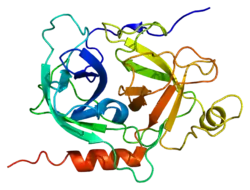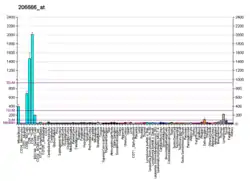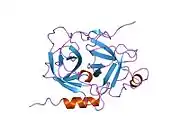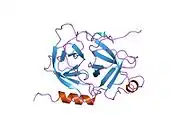| GZMK | |||||||||||||||||||||||||||||||||||||||||||||||||||
|---|---|---|---|---|---|---|---|---|---|---|---|---|---|---|---|---|---|---|---|---|---|---|---|---|---|---|---|---|---|---|---|---|---|---|---|---|---|---|---|---|---|---|---|---|---|---|---|---|---|---|---|
 | |||||||||||||||||||||||||||||||||||||||||||||||||||
| |||||||||||||||||||||||||||||||||||||||||||||||||||
| Identifiers | |||||||||||||||||||||||||||||||||||||||||||||||||||
| Aliases | GZMK, TRYP2, granzyme K | ||||||||||||||||||||||||||||||||||||||||||||||||||
| External IDs | OMIM: 600784 MGI: 1298232 HomoloGene: 20485 GeneCards: GZMK | ||||||||||||||||||||||||||||||||||||||||||||||||||
| |||||||||||||||||||||||||||||||||||||||||||||||||||
| |||||||||||||||||||||||||||||||||||||||||||||||||||
| |||||||||||||||||||||||||||||||||||||||||||||||||||
| |||||||||||||||||||||||||||||||||||||||||||||||||||
| |||||||||||||||||||||||||||||||||||||||||||||||||||
| Wikidata | |||||||||||||||||||||||||||||||||||||||||||||||||||
| |||||||||||||||||||||||||||||||||||||||||||||||||||
Granzyme K (GrK) is a protein that is encoded by the GZMK gene on chromosome 5 in humans.[5][6] Granzymes are a family of serine proteases which have various intracellular and extracellular roles. GrK is found in granules of natural killer (NK) cells and cytotoxic T lymphocytes (CTLs), and is traditionally described as being cytotoxic towards targeted foreign, infected, or cancerous cells. NK cells and CTLs can induce apoptosis through the granule secretory pathway, which involves the secretion of granzymes along with perforin at immunological synapses.
Intracellularly, GrK may cleave a variety of substrates, such as the nucleosome assembly protein (NAP),[7] HMG2,[7] and Ape1[8] in the ER-associated SET complex, along with other targets that have downstream cytotoxic effects. Compared to in vitro studies of GrK cytotoxicity in rats and humans, in vitro mouse studies show no cytotoxic potential in the absence of perforin, making the role of GrK controversial.[9][10] In vitro studies show potential extracellular targets for GrK such as the cleavage and activation of protease activated receptors (PAR)-1[11][12] and PAR-2.[13] Grk binds lipopolysaccharides (LPS) in vitro separately from GrK's catalytic activity.[14] Both PAR and LPS activation by GrK induce cytokine production in human in vitro studies.
GrK is important in bacterial and viral[15] infection control. GrK-expressing CD8+ T cells may be associated with inflammation and aging.[16]
References
- 1 2 3 GRCh38: Ensembl release 89: ENSG00000113088 - Ensembl, May 2017
- 1 2 3 GRCm38: Ensembl release 89: ENSMUSG00000042385 - Ensembl, May 2017
- ↑ "Human PubMed Reference:". National Center for Biotechnology Information, U.S. National Library of Medicine.
- ↑ "Mouse PubMed Reference:". National Center for Biotechnology Information, U.S. National Library of Medicine.
- ↑ Przetak MM, Yoast S, Schmidt BF (May 1995). "Cloning of cDNA for human granzyme 3". FEBS Letters. 364 (3): 268–271. doi:10.1016/0014-5793(95)00407-Z. PMID 7758581. S2CID 29315976.
- ↑ "Entrez Gene: GZMK granzyme K (granzyme 3; tryptase II)".
- 1 2 Zhao T, Zhang H, Guo Y, Zhang Q, Hua G, Lu H, et al. (March 2007). "Granzyme K cleaves the nucleosome assembly protein SET to induce single-stranded DNA nicks of target cells". Cell Death and Differentiation. 14 (3): 489–499. doi:10.1038/sj.cdd.4402040. PMID 17008916. S2CID 6044972.
- ↑ Guo Y, Chen J, Zhao T, Fan Z (April 2008). "Granzyme K degrades the redox/DNA repair enzyme Ape1 to trigger oxidative stress of target cells leading to cytotoxicity". Molecular Immunology. 45 (8): 2225–2235. doi:10.1016/j.molimm.2007.11.020. PMID 18179823.
- ↑ Susanto O, Trapani JA, Brasacchio D (December 2012). "Controversies in granzyme biology". Tissue Antigens. 80 (6): 477–487. doi:10.1111/tan.12014. PMID 23137319.
- ↑ Bouwman AC, van Daalen KR, Crnko S, ten Broeke T, Bovenschen N (2021). "Intracellular and Extracellular Roles of Granzyme K". Frontiers in Immunology. 12: 677707. doi:10.3389/fimmu.2021.677707. ISSN 1664-3224. PMC 8129556. PMID 34017346.
- ↑ Cooper DM, Pechkovsky DV, Hackett TL, Knight DA, Granville DJ (2011-06-30). "Granzyme K activates protease-activated receptor-1". PLOS ONE. 6 (6): e21484. Bibcode:2011PLoSO...621484C. doi:10.1371/journal.pone.0021484. PMC 3128063. PMID 21760880.
- ↑ Sharma M, Merkulova Y, Raithatha S, Parkinson LG, Shen Y, Cooper D, Granville DJ (May 2016). "Extracellular granzyme K mediates endothelial activation through the cleavage of protease-activated receptor-1". The FEBS Journal. 283 (9): 1734–1747. doi:10.1111/febs.13699. PMID 26936634. S2CID 21180451.
- ↑ Kaiserman D, Zhao P, Rowe CL, Leong A, Barlow N, Joeckel LT, et al. (2022-07-01). "Granzyme K initiates IL-6 and IL-8 release from epithelial cells by activating protease-activated receptor 2". PLOS ONE. 17 (7): e0270584. Bibcode:2022PLoSO..1770584K. doi:10.1371/journal.pone.0270584. PMC 9321427. PMID 35881628.
- ↑ Wensink AC, Kemp V, Fermie J, García Laorden MI, van der Poll T, Hack CE, Bovenschen N (April 2014). "Granzyme K synergistically potentiates LPS-induced cytokine responses in human monocytes". Proceedings of the National Academy of Sciences of the United States of America. 111 (16): 5974–5979. Bibcode:2014PNAS..111.5974W. doi:10.1073/pnas.1317347111. PMC 4000831. PMID 24711407.
- ↑ Zhong C, Li C, Wang X, Toyoda T, Gao G, Fan Z (May 2012). "Granzyme K inhibits replication of influenza virus through cleaving the nuclear transport complex importin α1/β dimer of infected host cells". Cell Death and Differentiation. 19 (5): 882–890. doi:10.1038/cdd.2011.178. PMC 3321629. PMID 22139131.
- ↑ Mogilenko DA, Shpynov O, Andhey PS, Arthur L, Swain A, Esaulova E, et al. (January 2021). "Comprehensive Profiling of an Aging Immune System Reveals Clonal GZMK+ CD8+ T Cells as Conserved Hallmark of Inflammaging". Immunity. 54 (1): 99–115.e12. doi:10.1016/j.immuni.2020.11.005. PMID 33271118. S2CID 227282306.
Further reading
- Smyth MJ, O'Connor MD, Trapani JA (November 1996). "Granzymes: a variety of serine protease specificities encoded by genetically distinct subfamilies". Journal of Leukocyte Biology. 60 (5): 555–562. doi:10.1002/jlb.60.5.555. PMID 8929545. S2CID 19732623.
- Shi L, Kam CM, Powers JC, Aebersold R, Greenberg AH (December 1992). "Purification of three cytotoxic lymphocyte granule serine proteases that induce apoptosis through distinct substrate and target cell interactions". The Journal of Experimental Medicine. 176 (6): 1521–1529. doi:10.1084/jem.176.6.1521. PMC 2119451. PMID 1460416.
{{cite journal}}: CS1 maint: overridden setting (link) - Hameed A, Lowrey DM, Lichtenheld M, Podack ER (November 1988). "Characterization of three serine esterases isolated from human IL-2 activated killer cells". Journal of Immunology. 141 (9): 3142–3147. doi:10.4049/jimmunol.141.9.3142. PMID 3262682.
- Baker E, Sayers TJ, Sutherland GR, Smyth MJ (1994). "The genes encoding NK cell granule serine proteases, human tryptase-2 (TRYP2) and human granzyme A (HFSP), both map to chromosome 5q11-q12 and define a new locus for cytotoxic lymphocyte granule tryptases". Immunogenetics. 40 (3): 235–237. doi:10.1007/BF00167085. PMID 8039831. S2CID 37615055.
- Sayers TJ, Lloyd AR, McVicar DW, O'Connor MD, Kelly JM, Carter CR, et al. (May 1996). "Cloning and expression of a second human natural killer cell granule tryptase, HNK-Tryp-2/granzyme 3". Journal of Leukocyte Biology. 59 (5): 763–768. doi:10.1002/jlb.59.5.763. PMID 8656064. S2CID 18065724.
{{cite journal}}: CS1 maint: overridden setting (link) - Hink-Schauer C, Estébanez-Perpiñá E, Wilharm E, Fuentes-Prior P, Klinkert W, Bode W, Jenne DE (December 2002). "The 2.2-A crystal structure of human pro-granzyme K reveals a rigid zymogen with unusual features". The Journal of Biological Chemistry. 277 (52): 50923–50933. doi:10.1074/jbc.M207962200. PMID 12384499.
{{cite journal}}: CS1 maint: overridden setting (link) - Fajardo I, Pejler G (February 2003). "Formation of active monomers from tetrameric human beta-tryptase". The Biochemical Journal. 369 (Pt 3): 603–610. doi:10.1042/BJ20021418. PMC 1223112. PMID 12387726.
- Zhao T, Zhang H, Guo Y, Zhang Q, Hua G, Lu H, et al. (March 2007). "Granzyme K cleaves the nucleosome assembly protein SET to induce single-stranded DNA nicks of target cells". Cell Death and Differentiation. 14 (3): 489–499. doi:10.1038/sj.cdd.4402040. PMID 17008916. S2CID 6044972.
{{cite journal}}: CS1 maint: overridden setting (link) - Zhao T, Zhang H, Guo Y, Fan Z (April 2007). "Granzyme K directly processes bid to release cytochrome c and endonuclease G leading to mitochondria-dependent cell death". The Journal of Biological Chemistry. 282 (16): 12104–12111. doi:10.1074/jbc.M611006200. PMID 17308307.
- Rucevic M, Fast LD, Jay GD, Trespalcios FM, Sucov A, Siryaporn E, Lim YP (May 2007). "Altered levels and molecular forms of granzyme k in plasma from septic patients". Shock. 27 (5): 488–493. doi:10.1097/01.shk.0000246905.24895.e5. PMID 17438453. S2CID 525904.
{{cite journal}}: CS1 maint: overridden setting (link)






